Related Research Articles

The Arabic alphabet, or Arabic abjad, is the Arabic script as it is codified for writing Arabic. It is written from right to left in a cursive style and includes 28 letters. Most letters have contextual letterforms. The Arabic script is also a religious text, it is used mainly in Islamic countries, namely in Arabia, North Africa, Persia/Iran, Central Asia and the Northwestern Indian Subcontinent.

The Shavian alphabet is an alphabet conceived as a way to provide simple, phonetic orthography for the English language to replace the difficulties of conventional spelling. It was posthumously funded by and named after Irish playwright Bernard Shaw. Shaw set three main criteria for the new alphabet: it should be (1) at least 40 letters; (2) as phonetic as possible ; and (3) distinct from the Latin alphabet to avoid the impression that the new spellings were simply misspellings.
The Thai script is the abugida used to write Thai, Southern Thai and many other languages spoken in Thailand. The Thai alphabet itself has 44 consonant symbols, 16 vowel symbols that combine into at least 32 vowel forms and four tone diacritics to create characters mostly representing syllables.

Shorthand is an abbreviated symbolic writing method that increases speed and brevity of writing as compared to longhand, a more common method of writing a language. The process of writing in shorthand is called stenography, from the Greek stenos (narrow) and graphein. It has also been called brachygraphy, from Greek brachys (short), and tachygraphy, from Greek tachys, depending on whether compression or speed of writing is the goal.
Dutton Speedwords, transcribed in Speedwords as Dutton Motez, is an international auxiliary language as well as an abbreviated writing system using the English alphabet for all the languages of the world. It was devised by Reginald J. G. Dutton (1886–1970) who initially ran a shorthand college promoting Dutton Shorthand, then offered a mail order (correspondence) self-education course in Speedwords while still supporting the Dutton Shorthand. The business was continued by his daughter Elizabeth after his death.
Pitman shorthand is a system of shorthand for the English language developed by Englishman Sir Isaac Pitman (1813–1897), who first presented it in 1837. Like most systems of shorthand, it is a phonetic system; the symbols do not represent letters, but rather sounds, and words are, for the most part, written as they are spoken. As of 1996, Pitman shorthand was the most popular shorthand system used in the United Kingdom and the second most popular in the United States.
Gabelsberger shorthand, named for its creator, is a form of shorthand previously common in Germany and Austria. Created c. 1817 by Franz Xaver Gabelsberger, it was first fully described in the 1834 textbook Anleitung zur deutschen Redezeichenkunst oder Stenographie and became rapidly used.
Gregg shorthand is a form of shorthand that was invented by John Robert Gregg in 1888. Like cursive longhand, it is completely based on elliptical figures and lines that bisect them. Gregg shorthand is the most popular form of pen stenography in the United States; its Spanish adaptation is fairly popular in Latin America. With the invention of dictation machines, shorthand machines, and the practice of executives writing their own letters on their personal computers, the use of shorthand has gradually declined in the business and reporting world. However, Gregg shorthand is still in use today.

Teeline is a shorthand system developed in 1968 by James Hill, a teacher of Pitman Shorthand. It is accepted by the National Council for the Training of Journalists, which certifies the training of journalists in the United Kingdom.
Personal Shorthand, originally known as Briefhand in the 1950s, is a completely alphabetic shorthand.
Thomas Natural Shorthand is an English shorthand system created by Charles A. Thomas which was first published in 1935. Thomas described his system as "designed to meet the existing need for a simple, legible shorthand that is based on already familiar writing lines, and that is written with a minimum number of rules." The system has fallen into disuse with the decline of pen shorthand in the later 20th century, but the spirit of the system lives on in Teeline shorthand, with which it shares a number of characteristics.

Eclectic shorthand is an English shorthand system of the 19th century. Although it has fallen into disuse, it is nonetheless noteworthy as one of the most compact systems of writing ever devised.
In a featural writing system, the shapes of the symbols are not arbitrary but encode phonological features of the phonemes that they represent. The term featural was introduced by Geoffrey Sampson to describe the Korean alphabet and Pitman shorthand.
Speedwriting is the trademark under which three versions of a shorthand system were marketed during the 20th century. The original version was designed so that it could be written with a pen or typed on a typewriter. At the peak of its popularity, Speedwriting was taught in more than 400 vocational schools and its advertisements were ubiquitous in popular American magazines.

Bezenšek Shorthand is a shorthand system, used for rapidly recording Bulgarian speech. The system was invented by the Slovene linguist Anton Bezenšek c. 1879. It is based on the Gabelsberger shorthand, so it is often referred to as the Gabelsberger–Bezenšek Shorthand.
SuperWrite is an English shorthand system based largely on previous shorthand systems and largely intended for people who need to increase their writing speed without devoting months to learning more complicated systems. It is a writing system, as it uses cursive forms of the letters of the spoken alphabet to represent sounds. Aside from assigning special abbreviations to common words, the system functions largely by omitting short vowels from within words. Hence, SuperWrite could be considered an impure abjad. Its publishers claim it uses only the 26 letters of the longhand alphabet with no extra symbols, however, the capital letters used have different functions from their lowercase forms, and the uncrossed t — which would be considered a mistake in longhand — has a different function from the crossed t, bringing the total number of symbols in SuperWrite to 33. SuperWrite was developed by A. James Lemaster, with assistance from Ellen Hankin and John Metz Baer.
Stenoscript or Stenoscript ABC Shorthand is a shorthand system invented by Manuel C. Avancena (1923–1987) and first published in 1950. Encyclopædia Britannica, perhaps erroneously, claims the system was originally published in London in 1607. An unrelated project also called Stenoscript was written by George A.S. Oliver and published in London in 1934.

The Duployan shorthand, or Duployan stenography, was created by Father Émile Duployé in 1860 for writing French. Since then, it has been expanded and adapted for writing English, German, Spanish, Romanian, and Chinook Jargon. The Duployan stenography is classified as a geometric, alphabetic stenography and is written left-to-right in connected stenographic style. The Duployan shorthands, including Chinook writing, Pernin's Universal Phonography, Perrault's English Shorthand, the Sloan-Duployan Modern Shorthand, and Romanian stenography, were included as a single script in version 7.0 of the Unicode Standard / ISO 10646

The system of geometric shorthand published in Britain by Samuel Taylor in 1786, under the title An essay intended to establish a standard for an universal system of Stenography, or Short-hand writing, was the first shorthand system to be used across the English-speaking world. Taylor shorthand uses an alphabet of 19 letters of simplified shape. His book was translated and published in France by Théodore-Pierre Bertin in 1792 under the title Système universel et complet de Stenographie ou Manière abrégée d'écrire applicable à tous les idiomes.
References
- ↑ Forkner shorthand for colleges. Forkner/Gage. 1982. p. 18. ISBN 0912036443.
- ↑ Forkner shorthand for colleges. Forkner/Gage. 1982. p. 3. ISBN 0912036443.
- ↑ Forkner shorthand for colleges. Forkner/Gage. 1982. p. 8. ISBN 0912036443.
- ↑ Forkner shorthand for colleges. Forkner/Gage. 1982. p. 13. ISBN 0912036443.
- ↑ Alldredge, Steve (29 Dec 1974). "It's Not Swahili, It's A New Shorthand". Naples Daily News (paywalled archive). Retrieved 16 November 2014.
- ↑ "Shortcut to Shorthand". Ottawa Citizen. 16 May 1969. Retrieved 16 November 2014.
- ↑ "Shorthand Studies" in Montreal Gazette, 4 August 1964
- ↑ "New Course Offering, evening classes for adults". Delaware County Daily Times (paywalled archive). 14 Jan 1972. Retrieved 16 November 2014.
- ↑ Madsen, Julie: A comparison of the shorthand skills of first-year high school students using Century 21 or Forkner shorthand (1983)
- ↑ Jensen, Kathleen A.: A comparison study of Gregg, Forkner, and machine shorthand to determine ease in learning, usage, and retention (1980)
- ↑ Ribling, Pearl M.W.: A comparative study of the performance of students in Gregg shorthand, Diamond Jubilee series and Forkner shorthand in the Seattle public schools (1967)
- ↑ "business teachers' workshop scheduled". The Southern Illionoisan (paywalled archive). 26 June 1960. Retrieved 16 November 2014.
- ↑ "Faster type of shorthand". The Brandon Sun, Manitoba (paywalled archive). 5 August 1964. Retrieved 15 November 2014.